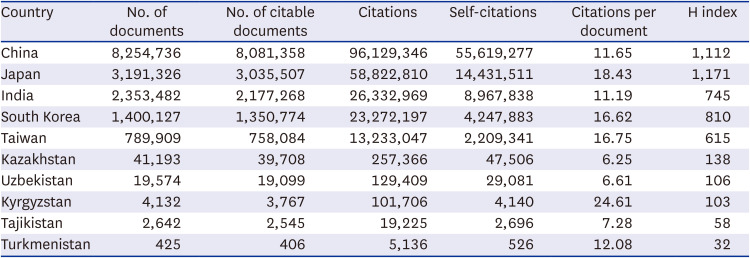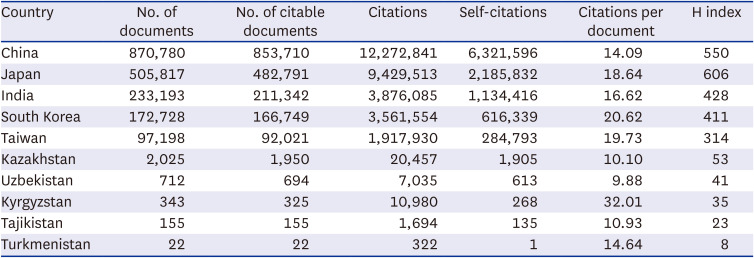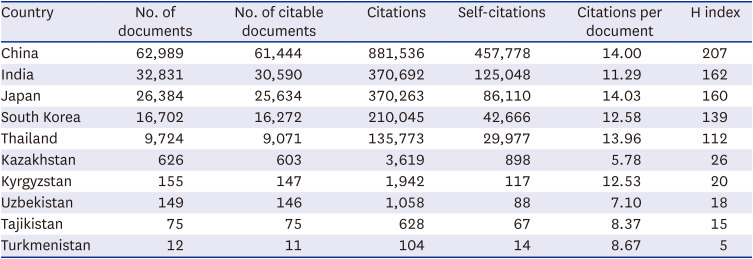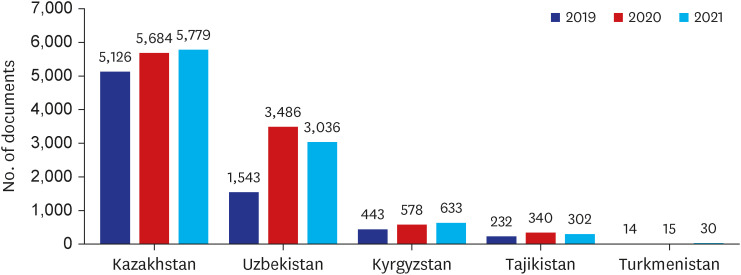This article has been
cited by other articles in ScienceCentral.
Abstract
Background
Central Asian countries (CACs) are less visible in the global scientific environment, despite their solid scientific nature. The current article aimed to assess the publication productivity of CACs since 1996 using SCImago Journal & Country Rank (SJR).
Methods
This is a descriptive study. The SJR portal was used to retrieve the data. The Country Rankings section was viewed, and the Asiatic Region option was chosen. The most active countries and CACs’ number of documents, number of citable documents, citations, self-citations, citations per document, and H index data were obtained. The number of documents from CACs was recorded annually to determine the ten-year trend (2012 to 2021). Scientific categories in which CACs were prolific were defined.
Results
Between 1996 and 2021, 18,336,647 documents with Asian region origins were produced. The most active countries in the Asiatic Region were China (1st), Japan (2nd), India (3rd), South Korea (4th), and Taiwan (5th). According to the number of documents, Kazakhstan ranked 15th, Uzbekistan 19th, Kyrgyzstan 24th, Tajikistan 27th, and Turkmenistan 31st among the Asiatic Region countries. The total number of documents originating from CACS, which was 1,616 in 2012, increased to 9,780 in 2021 with an upward trend (6.05 fold increase).
Conclusion
Despite a rising number of articles, CACs are not at the forefront of scientific productivity in the Asiatic Region. Kazakhstan is the leading country in scientific productivity among CACs. Nonetheless, the increasing quantity of articles from CACs over the last ten years suggests that these countries have the infrastructure and human resources to enhance scientific research and production.
Keywords: Central Asia, Periodicals as Topic, Publishing Trends, Bibliometrics, Language, Medicine
INTRODUCTION
Despite having a strong scientific nature, Central Asian countries (CACs) are less visible in the international scientific environment. This can be due to dependence on local and international journals that are not sufficiently visible in the scientific community, not listed in reputable indexes, and a lack of exposure to foreign research.
12 CACs have no restrictions on the number of researchers. However, many young researchers may need more mentoring and scientific guidance, and regular and broad access to online platforms may not be possible.
3 This condition has changed over time. Some countries are on the rise scientifically, and some need to catch up on publications. The increasing number of articles from the CACs reflects the growing scientific curiosity and the rising endeavor to comprehend research’s purpose, complexity, and ethics.
45
A comprehensive and impartial assessment of the region’s scientific output as a whole, and its comparison with global statistics, can be a precious analytical tool for creating reference points in developing a research strategy and easing decision-making.
6 One of the available methods to monitor the impact of the dissemination of research results as published scientific articles is bibliometric analysis.
7 Bibliometric analysis is widely recognized as a reliable tool for assessing scientific output, focusing on the number of papers and citations published on a particular subject, presenting trend analyses, and identifying productive countries.
8
Regarding the indicators of scientific papers on countries, SCImago Journal & Country Rank (SJR) provides a platform that is open to the public and free of charge. This platform provides data and visualizes rankings that can be used to analyze or compare indicators based on information from articles listed in Elsevier’s Scopus database since 1996.
9 On SJR, there are options for subject areas, subject categories, and regions. In addition, since 1996, the desired date range’s data can be displayed.
10
The current article aimed to evaluate the publication productivity of CACs (Kazakhstan, Uzbekistan, Kyrgyzstan, Tajikistan, Turkmenistan) since 1996 using SJR. We planned to conduct these analyses for the ‘all subject category,’ medicine category,’ and ‘public health, environmental and occupational health category.’ We aimed to perform a trend analysis of the last ten years (from 2012 to 2021) regarding the number of articles from CACs. Finally, we aimed to determine the most prolific subject category for each of the CACs.
METHODS
This is a descriptive study. Data were obtained through the SJR portal (
https://www.scimagojr.com/). First, the Country Rankings section was accessed, and the Asiatic Region option was selected. Next, the listing was based on the number of documents; thus, the countries providing the most articles were placed at the top of the list. According to the number of documents, the top five countries in the list were categorized as the most active countries. The number of documents, number of citable documents, citations, self-citations, citations per document, and H index data of most active countries and CACs were recorded. These data were collected individually between 1996 and 2021 for the ‘all subject category,’ ‘medicine category,’ and ‘public health, environmental, and occupational health category.’
The number of documents from CACs was noted yearly to determine the trend for the last ten years (2012 to 2021). The rankings of CACs among Asiatic Region countries in terms of the number of documents, the number of citations per document, and the H index were recorded (using all subject categories). All subject categories were reviewed. The category in which each CAC ranks highest among the Asiatic Region countries was identified. Thus, the categories in which CACs are prolific were revealed.
The Journal Rankings section was accessed through the SJR portal, and the Asiatic Region option was selected. Journals were listed according to the SCImago Journal Rank indicator score. Journals sourced from CACs were noted.
Data were entered into an Excel file, and charts were created in Excel. The data was expressed using numbers and rankings.
There are no humans or animals involved. The publicly available data was collected and evaluated. As a result, no ethics committee approval is required.
11
RESULTS
SJR lists data from 33 countries when the Asiatic Region option is chosen. The total number of documents originating from countries in the Asiatic Region between 1996 and 2021 is 18,336,647. Based on the total number of documents, the most active Asiatic Region countries were identified: China (1st), Japan (2nd), India (3rd), South Korea (4th), and Taiwan (5th). Among the CACs, Kazakhstan ranked 15th, Uzbekistan 19th, Kyrgyzstan 24th, Tajikistan 27th, and Turkmenistan 31st (
Table 1).
Tables 2 and
3 present the outcomes of the listings based on the medical category data and the public health, environmental, and occupational health category data.
Table 1
Most active countries in Asiatic region and Central Asian countries (all subject categories data)

|
Country |
No. of documents |
No. of citable documents |
Citations |
Self-citations |
Citations per document |
H index |
|
China |
8,254,736 |
8,081,358 |
96,129,346 |
55,619,277 |
11.65 |
1,112 |
|
Japan |
3,191,326 |
3,035,507 |
58,822,810 |
14,431,511 |
18.43 |
1,171 |
|
India |
2,353,482 |
2,177,268 |
26,332,969 |
8,967,838 |
11.19 |
745 |
|
South Korea |
1,400,127 |
1,350,774 |
23,272,197 |
4,247,883 |
16.62 |
810 |
|
Taiwan |
789,909 |
758,084 |
13,233,047 |
2,209,341 |
16.75 |
615 |
|
Kazakhstan |
41,193 |
39,708 |
257,366 |
47,506 |
6.25 |
138 |
|
Uzbekistan |
19,574 |
19,099 |
129,409 |
29,081 |
6.61 |
106 |
|
Kyrgyzstan |
4,132 |
3,767 |
101,706 |
4,140 |
24.61 |
103 |
|
Tajikistan |
2,642 |
2,545 |
19,225 |
2,696 |
7.28 |
58 |
|
Turkmenistan |
425 |
406 |
5,136 |
526 |
12.08 |
32 |
Table 2
Most active countries in Asiatic region and Central Asian countries (medicine category data)

|
Country |
No. of documents |
No. of citable documents |
Citations |
Self-citations |
Citations per document |
H index |
|
China |
870,780 |
853,710 |
12,272,841 |
6,321,596 |
14.09 |
550 |
|
Japan |
505,817 |
482,791 |
9,429,513 |
2,185,832 |
18.64 |
606 |
|
India |
233,193 |
211,342 |
3,876,085 |
1,134,416 |
16.62 |
428 |
|
South Korea |
172,728 |
166,749 |
3,561,554 |
616,339 |
20.62 |
411 |
|
Taiwan |
97,198 |
92,021 |
1,917,930 |
284,793 |
19.73 |
314 |
|
Kazakhstan |
2,025 |
1,950 |
20,457 |
1,905 |
10.10 |
53 |
|
Uzbekistan |
712 |
694 |
7,035 |
613 |
9.88 |
41 |
|
Kyrgyzstan |
343 |
325 |
10,980 |
268 |
32.01 |
35 |
|
Tajikistan |
155 |
155 |
1,694 |
135 |
10.93 |
23 |
|
Turkmenistan |
22 |
22 |
322 |
1 |
14.64 |
8 |
Table 3
Most active countries in Asiatic region and Central Asian countries (public health, environmental and occupational health category data)

|
Country |
No. of documents |
No. of citable documents |
Citations |
Self-citations |
Citations per document |
H index |
|
China |
62,989 |
61,444 |
881,536 |
457,778 |
14.00 |
207 |
|
India |
32,831 |
30,590 |
370,692 |
125,048 |
11.29 |
162 |
|
Japan |
26,384 |
25,634 |
370,263 |
86,110 |
14.03 |
160 |
|
South Korea |
16,702 |
16,272 |
210,045 |
42,666 |
12.58 |
139 |
|
Thailand |
9,724 |
9,071 |
135,773 |
29,977 |
13.96 |
112 |
|
Kazakhstan |
626 |
603 |
3,619 |
898 |
5.78 |
26 |
|
Kyrgyzstan |
155 |
147 |
1,942 |
117 |
12.53 |
20 |
|
Uzbekistan |
149 |
146 |
1,058 |
88 |
7.10 |
18 |
|
Tajikistan |
75 |
75 |
628 |
67 |
8.37 |
15 |
|
Turkmenistan |
12 |
11 |
104 |
14 |
8.67 |
5 |
The distribution of documents originating from CACs from 2012 to 2021 (ten years of data) is presented in
Fig. 1. The total number of documents increased from 1,616 in 2012 to 9,780 in 2021, with an upward trend (6.05 fold increase). The total number of documents from CACs in 2019, 2020, and 2021 is visualized in
Fig. 2.
Fig. 1
Publication trend of Central Asian countries from 2012 to 2021.

Fig. 2
Number of documents of Central Asian countries in 2019, 2020 and 2021.

In the listing according to the number of citations per document, the CACs were ranked as follows: Kyrgyzstan (24.61) ranked 3rd, Turkmenistan (12.08) 23rd, Tajikistan (7.28) 30th, Uzbekistan (6.61) 31st, and Kazakhstan (6.25) 32nd. In the ranking of Asiatic Region countries according to the H index, Kazakhstan (138) was 18th, Uzbekistan (106) 22nd, Kyrgyzstan (103) 24th, Tajikistan (58) 28th and Turkmenistan (32) 31st.
An analysis was conducted to determine the subject categories in which the countries of Central Asia are the most prolific. The subject category in which Kazakhstan is at the forefront is Medical Assisting and Transcription (3rd place). Classics for Uzbekistan (6th place), Respiratory Care for Kyrgyzstan (11th place), Astronomy and Astrophysics, Music and Space and Planetary Science for Tajikistan (17th place for each), and Analysis for Turkmenistan (18th place).
A total of 2,697 journals originating from Asiatic Region countries were listed (according to the data of 2021). Seven journals from Kazakhstan were identified when the list was examined in terms of CACs. There were no journals sourced from the remaining four countries (Uzbekistan, Kyrgyzstan, Tajikistan, and Turkmenistan).
DISCUSSION
The results demonstrated that there were substantial disparities amongst CACs in terms of publication output and the scientific productivity of CACs was relatively low. Kazakhstan stands out among the CACs regarding the number of documents and H index. In terms of the number of documents originating from CACs, the last ten-year data shows an upward trend. China, Japan, and India rank high in almost all categories and hold the lead with article counts.
Regarding the number of documents (all subject categories), Kazakhstan ranked 15th, Uzbekistan 19th, Kyrgyzstan 24th, Tajikistan 27th, and Turkmenistan 31st among CACs. A considerable difference stands out when compared to the data of the most active countries in the Asiatic Region. The data of the medicine and public health, environmental health, and occupational health categories also support this difference. Publication productivity is a complex issue and is influenced by multiple factors. Therefore, conducting a complete analysis of the reasons influencing CACs’ relatively low rankings in publication productivity is challenging. However, several factors have the potential to affect the results. Personal, environmental, and behavioral factors are associated with scientific publication productivity among researchers. Inadequate funding, a low familiarity with foreign languages (particularly English), a lack of high-level research centers and journals indexed in international and reputable databases, limited experience in publishing articles in high-impact journals, and a lack of researchers who provide mentorship are all potential major factors.
1213 The varying capacities of CACs to access the Internet are another aspect that may have an impact.
14 At this stage, CACs should first make an effort to determine which of the possible factors profoundly affect scientific productivity. Afterward, an appropriate action plan should be prepared by meeting with policymakers. Support should be sought from internationally experienced researchers, academics, and research centers with deep scientific roots if needed.
When the total number of documents from CACs was examined during the last ten years, it increased from 1616 in 2012 to 9780 in 2021, with an upward trend (6.05 fold increase). In addition, the distribution of documents covering 2019, 2020, and 2021 supports Kazakhstan’s leadership among the CACs. These results reveal that CACs have recently increased scientific productivity.
15 Although the outcomes were far from ideal, the positive consequences of the scientific development effort began to emerge. Nevertheless, CACs are reconstructing their scientific ability, and it is evident that they have a long way to go. Kazakhstan could serve as a model for other CACs. Examining the leading country in Central Asia can provide useful data in addition to creating international connections. It will be important for CACs to reflect regional dynamics.
The categories in which CACs are prolific, and their rankings in these categories differ from each other. These categories are Medical Assisting and Transcription for Kazakhstan, Classics for Uzbekistan, Respiratory Care for Kyrgyzstan, Astronomy and Astrophysics, Music and Space and Planetary Science for Tajikistan, and Analysis for Turkmenistan. It should be noted that each country’s dynamics in the scientific environment may differ.
16 Therefore, each country’s scientific dynamics should be considered while developing a joint scientific development action plan for CACs, and modifications should be made as needed. Each CAC should decide on the scientific area it will prioritize in development based on its local dynamics.
Although seven journals from Kazakhstan were listed, no journals from the other four countries (Uzbekistan, Kyrgyzstan, Tajikistan, and Turkmenistan) were identified. Therefore, CACs should prioritize the inclusion of their local journals in reputable indexes. An action plan should be created for this purpose, and if necessary, cooperation from internationally experienced editors should be sought. This process should be regarded as part of scientific advancement.
One of the study’s strengths is its ability to comprehensively evaluate CAC publishing data since 1996. This method allows us to review publication trends objectively across many categories. However, one of the main limitations is the inability to access data before 1996. Other limitations are using a single database and the inability to assess scientific productivity in non-English languages and local journals.
In conclusion, CACs are not at the forefront of Asiatic Region scientific productivity. On the other hand, China, Japan, and India rank high in almost all categories due to policies, allocated budgets, and scientific roots. Kazakhstan is the leading country among the CACs in scientific productivity and the H index. CACs should investigate their deficiencies in-depth, regionally, and within each country. While analyzing the scientific progress of China, Japan, and India, Kazakhstan, the regional leader, can serve as a model for the other four countries. It is important to remember that each country’s local dynamics may differ when establishing a general framework for scientific progress. Nevertheless, the growing number of papers from CACs over the ten years indicates that these countries have the infrastructure and human resources for scientific advancement and production. At this point, mobilizing resources and providing proper guidance will aid in improving the scientific productivity of CACs. Central Asian research managers should prioritize the quality, visibility, and indexability of their local journals and advance the scientific level of their researchers by targeting reliable and widely visible international sources.







 PDF
PDF Citation
Citation Print
Print





 XML Download
XML Download